CHEVROLET KODIAK 2007 Owners Manual
Manufacturer: CHEVROLET, Model Year: 2007, Model line: KODIAK, Model: CHEVROLET KODIAK 2007Pages: 430, PDF Size: 6.06 MB
Page 211 of 430
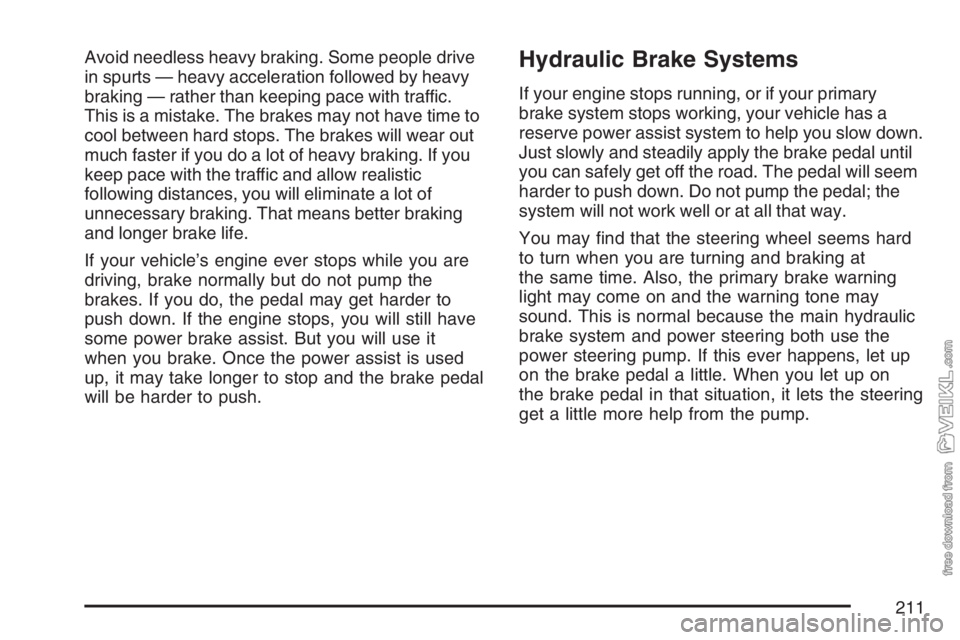
Avoid needless heavy braking. Some people drive
in spurts — heavy acceleration followed by heavy
braking — rather than keeping pace with traffic.
This is a mistake. The brakes may not have time to
cool between hard stops. The brakes will wear out
much faster if you do a lot of heavy braking. If you
keep pace with the traffic and allow realistic
following distances, you will eliminate a lot of
unnecessary braking. That means better braking
and longer brake life.
If your vehicle’s engine ever stops while you are
driving, brake normally but do not pump the
brakes. If you do, the pedal may get harder to
push down. If the engine stops, you will still have
some power brake assist. But you will use it
when you brake. Once the power assist is used
up, it may take longer to stop and the brake pedal
will be harder to push.Hydraulic Brake Systems
If your engine stops running, or if your primary
brake system stops working, your vehicle has a
reserve power assist system to help you slow down.
Just slowly and steadily apply the brake pedal until
you can safely get off the road. The pedal will seem
harder to push down. Do not pump the pedal; the
system will not work well or at all that way.
You may find that the steering wheel seems hard
to turn when you are turning and braking at
the same time. Also, the primary brake warning
light may come on and the warning tone may
sound. This is normal because the main hydraulic
brake system and power steering both use the
power steering pump. If this ever happens, let up
on the brake pedal a little. When you let up on
the brake pedal in that situation, it lets the steering
get a little more help from the pump.
211
Page 212 of 430
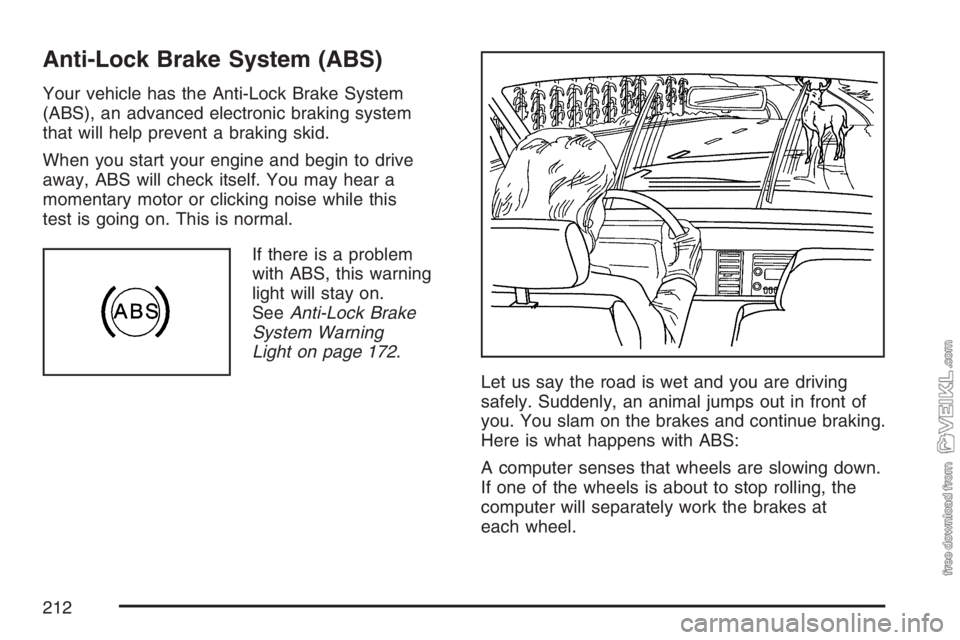
Anti-Lock Brake System (ABS)
Your vehicle has the Anti-Lock Brake System
(ABS), an advanced electronic braking system
that will help prevent a braking skid.
When you start your engine and begin to drive
away, ABS will check itself. You may hear a
momentary motor or clicking noise while this
test is going on. This is normal.
If there is a problem
with ABS, this warning
light will stay on.
SeeAnti-Lock Brake
System Warning
Light on page 172.
Let us say the road is wet and you are driving
safely. Suddenly, an animal jumps out in front of
you. You slam on the brakes and continue braking.
Here is what happens with ABS:
A computer senses that wheels are slowing down.
If one of the wheels is about to stop rolling, the
computer will separately work the brakes at
each wheel.
212
Page 213 of 430
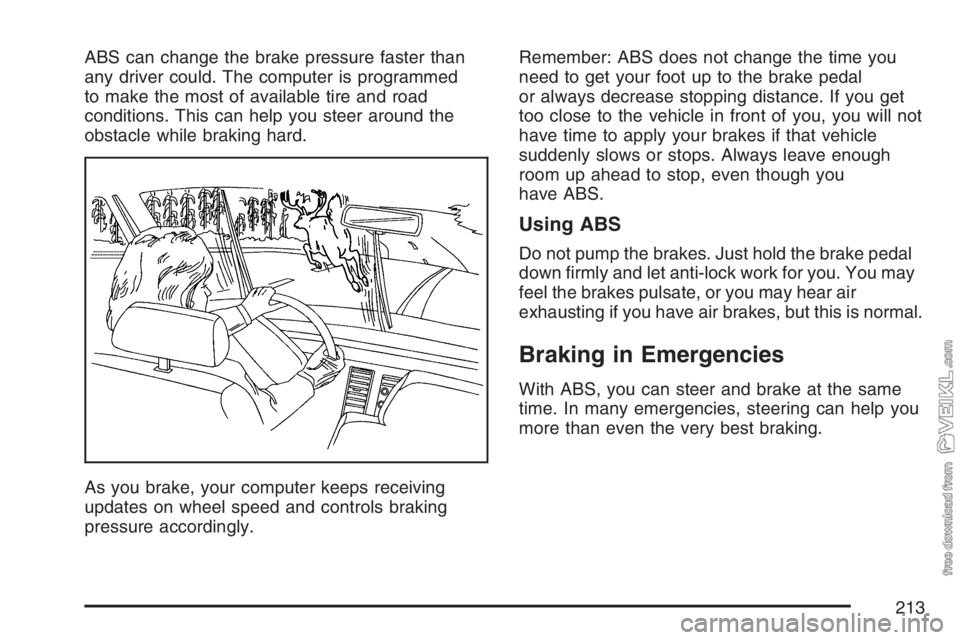
ABS can change the brake pressure faster than
any driver could. The computer is programmed
to make the most of available tire and road
conditions. This can help you steer around the
obstacle while braking hard.
As you brake, your computer keeps receiving
updates on wheel speed and controls braking
pressure accordingly.Remember: ABS does not change the time you
need to get your foot up to the brake pedal
or always decrease stopping distance. If you get
too close to the vehicle in front of you, you will not
have time to apply your brakes if that vehicle
suddenly slows or stops. Always leave enough
room up ahead to stop, even though you
have ABS.
Using ABS
Do not pump the brakes. Just hold the brake pedal
down firmly and let anti-lock work for you. You may
feel the brakes pulsate, or you may hear air
exhausting if you have air brakes, but this is normal.
Braking in Emergencies
With ABS, you can steer and brake at the same
time. In many emergencies, steering can help you
more than even the very best braking.
213
Page 214 of 430
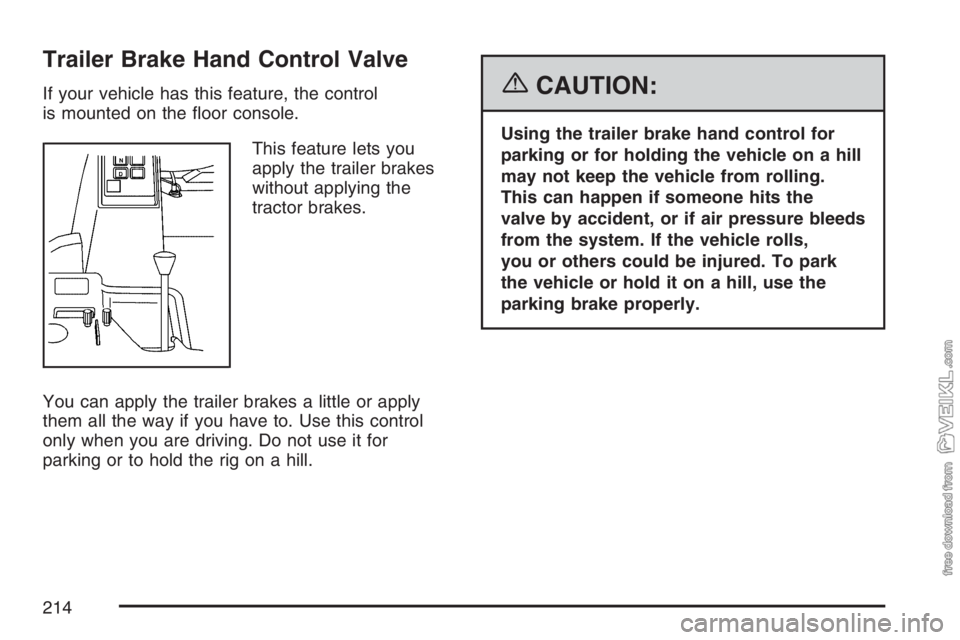
Trailer Brake Hand Control Valve
If your vehicle has this feature, the control
is mounted on the floor console.
This feature lets you
apply the trailer brakes
without applying the
tractor brakes.
You can apply the trailer brakes a little or apply
them all the way if you have to. Use this control
only when you are driving. Do not use it for
parking or to hold the rig on a hill.{CAUTION:
Using the trailer brake hand control for
parking or for holding the vehicle on a hill
may not keep the vehicle from rolling.
This can happen if someone hits the
valve by accident, or if air pressure bleeds
from the system. If the vehicle rolls,
you or others could be injured. To park
the vehicle or hold it on a hill, use the
parking brake properly.
214
Page 215 of 430
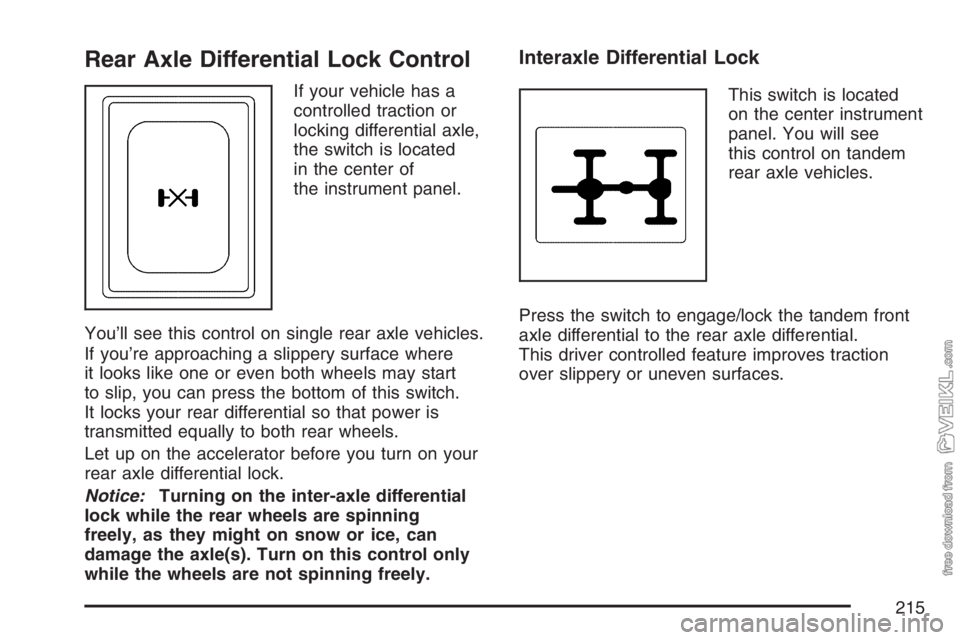
Rear Axle Differential Lock Control
If your vehicle has a
controlled traction or
locking differential axle,
the switch is located
in the center of
the instrument panel.
You’ll see this control on single rear axle vehicles.
If you’re approaching a slippery surface where
it looks like one or even both wheels may start
to slip, you can press the bottom of this switch.
It locks your rear differential so that power is
transmitted equally to both rear wheels.
Let up on the accelerator before you turn on your
rear axle differential lock.
Notice:Turning on the inter-axle differential
lock while the rear wheels are spinning
freely, as they might on snow or ice, can
damage the axle(s). Turn on this control only
while the wheels are not spinning freely.
Interaxle Differential Lock
This switch is located
on the center instrument
panel. You will see
this control on tandem
rear axle vehicles.
Press the switch to engage/lock the tandem front
axle differential to the rear axle differential.
This driver controlled feature improves traction
over slippery or uneven surfaces.
215
Page 216 of 430
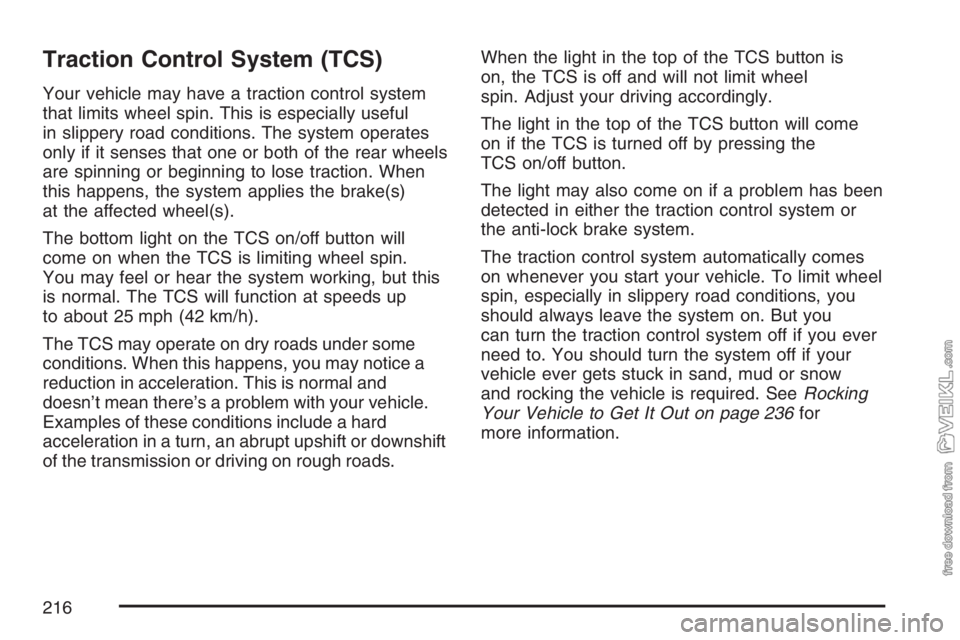
Traction Control System (TCS)
Your vehicle may have a traction control system
that limits wheel spin. This is especially useful
in slippery road conditions. The system operates
only if it senses that one or both of the rear wheels
are spinning or beginning to lose traction. When
this happens, the system applies the brake(s)
at the affected wheel(s).
The bottom light on the TCS on/off button will
come on when the TCS is limiting wheel spin.
You may feel or hear the system working, but this
is normal. The TCS will function at speeds up
to about 25 mph (42 km/h).
The TCS may operate on dry roads under some
conditions. When this happens, you may notice a
reduction in acceleration. This is normal and
doesn’t mean there’s a problem with your vehicle.
Examples of these conditions include a hard
acceleration in a turn, an abrupt upshift or downshift
of the transmission or driving on rough roads.When the light in the top of the TCS button is
on, the TCS is off and will not limit wheel
spin. Adjust your driving accordingly.
The light in the top of the TCS button will come
on if the TCS is turned off by pressing the
TCS on/off button.
The light may also come on if a problem has been
detected in either the traction control system or
the anti-lock brake system.
The traction control system automatically comes
on whenever you start your vehicle. To limit wheel
spin, especially in slippery road conditions, you
should always leave the system on. But you
can turn the traction control system off if you ever
need to. You should turn the system off if your
vehicle ever gets stuck in sand, mud or snow
and rocking the vehicle is required. SeeRocking
Your Vehicle to Get It Out on page 236for
more information.
216
Page 217 of 430
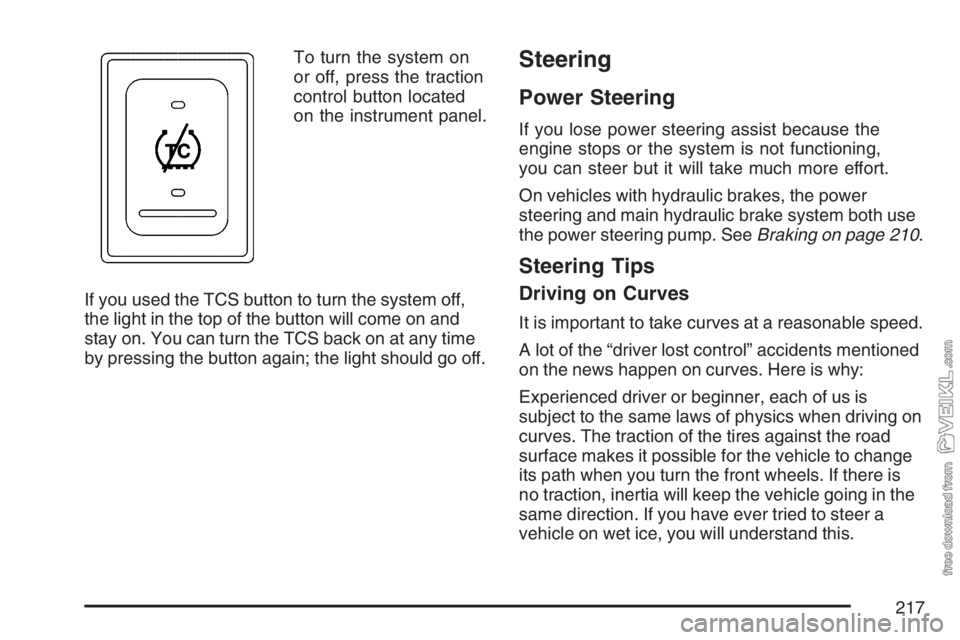
To turn the system on
or off, press the traction
control button located
on the instrument panel.
If you used the TCS button to turn the system off,
the light in the top of the button will come on and
stay on. You can turn the TCS back on at any time
by pressing the button again; the light should go off.Steering
Power Steering
If you lose power steering assist because the
engine stops or the system is not functioning,
you can steer but it will take much more effort.
On vehicles with hydraulic brakes, the power
steering and main hydraulic brake system both use
the power steering pump. SeeBraking on page 210.
Steering Tips
Driving on Curves
It is important to take curves at a reasonable speed.
A lot of the “driver lost control” accidents mentioned
on the news happen on curves. Here is why:
Experienced driver or beginner, each of us is
subject to the same laws of physics when driving on
curves. The traction of the tires against the road
surface makes it possible for the vehicle to change
its path when you turn the front wheels. If there is
no traction, inertia will keep the vehicle going in the
same direction. If you have ever tried to steer a
vehicle on wet ice, you will understand this.
217
Page 218 of 430
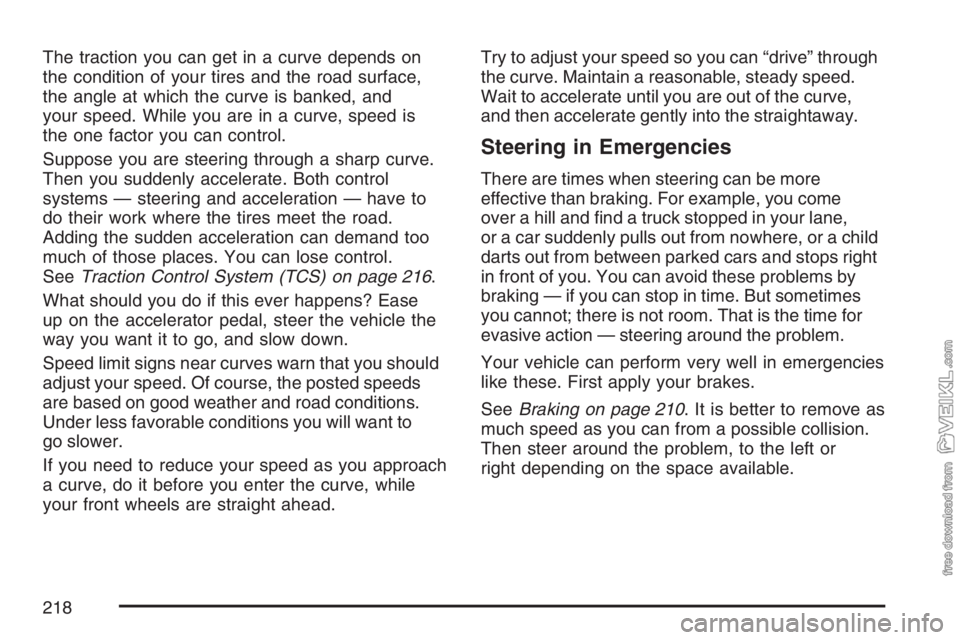
The traction you can get in a curve depends on
the condition of your tires and the road surface,
the angle at which the curve is banked, and
your speed. While you are in a curve, speed is
the one factor you can control.
Suppose you are steering through a sharp curve.
Then you suddenly accelerate. Both control
systems — steering and acceleration — have to
do their work where the tires meet the road.
Adding the sudden acceleration can demand too
much of those places. You can lose control.
SeeTraction Control System (TCS) on page 216.
What should you do if this ever happens? Ease
up on the accelerator pedal, steer the vehicle the
way you want it to go, and slow down.
Speed limit signs near curves warn that you should
adjust your speed. Of course, the posted speeds
are based on good weather and road conditions.
Under less favorable conditions you will want to
go slower.
If you need to reduce your speed as you approach
a curve, do it before you enter the curve, while
your front wheels are straight ahead.Try to adjust your speed so you can “drive” through
the curve. Maintain a reasonable, steady speed.
Wait to accelerate until you are out of the curve,
and then accelerate gently into the straightaway.
Steering in Emergencies
There are times when steering can be more
effective than braking. For example, you come
over a hill and find a truck stopped in your lane,
or a car suddenly pulls out from nowhere, or a child
darts out from between parked cars and stops right
in front of you. You can avoid these problems by
braking — if you can stop in time. But sometimes
you cannot; there is not room. That is the time for
evasive action — steering around the problem.
Your vehicle can perform very well in emergencies
like these. First apply your brakes.
SeeBraking on page 210. It is better to remove as
much speed as you can from a possible collision.
Then steer around the problem, to the left or
right depending on the space available.
218
Page 219 of 430
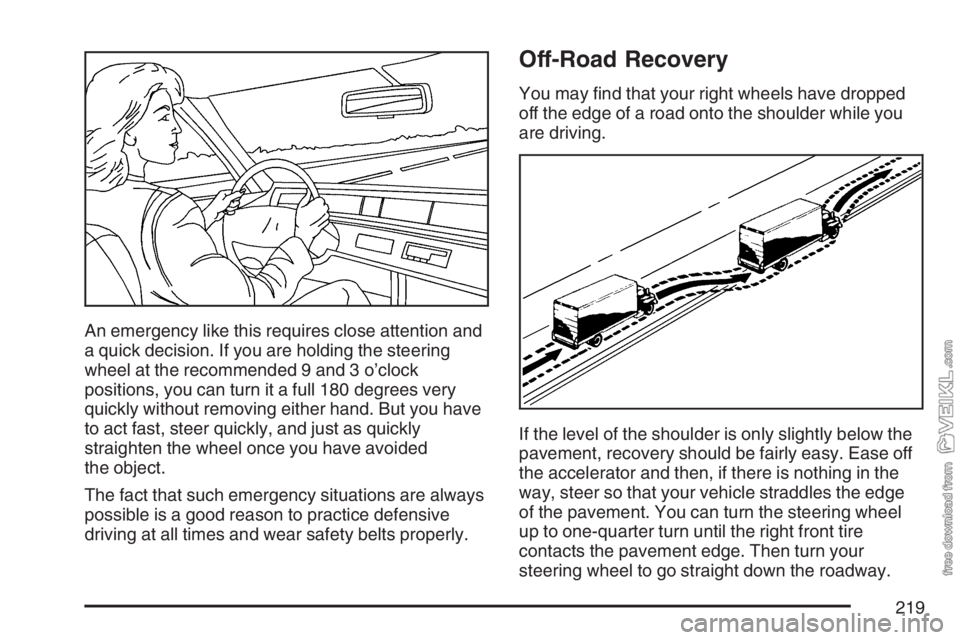
An emergency like this requires close attention and
a quick decision. If you are holding the steering
wheel at the recommended 9 and 3 o’clock
positions, you can turn it a full 180 degrees very
quickly without removing either hand. But you have
to act fast, steer quickly, and just as quickly
straighten the wheel once you have avoided
the object.
The fact that such emergency situations are always
possible is a good reason to practice defensive
driving at all times and wear safety belts properly.
Off-Road Recovery
You may find that your right wheels have dropped
off the edge of a road onto the shoulder while you
are driving.
If the level of the shoulder is only slightly below the
pavement, recovery should be fairly easy. Ease off
the accelerator and then, if there is nothing in the
way, steer so that your vehicle straddles the edge
of the pavement. You can turn the steering wheel
up to one-quarter turn until the right front tire
contacts the pavement edge. Then turn your
steering wheel to go straight down the roadway.
219
Page 220 of 430
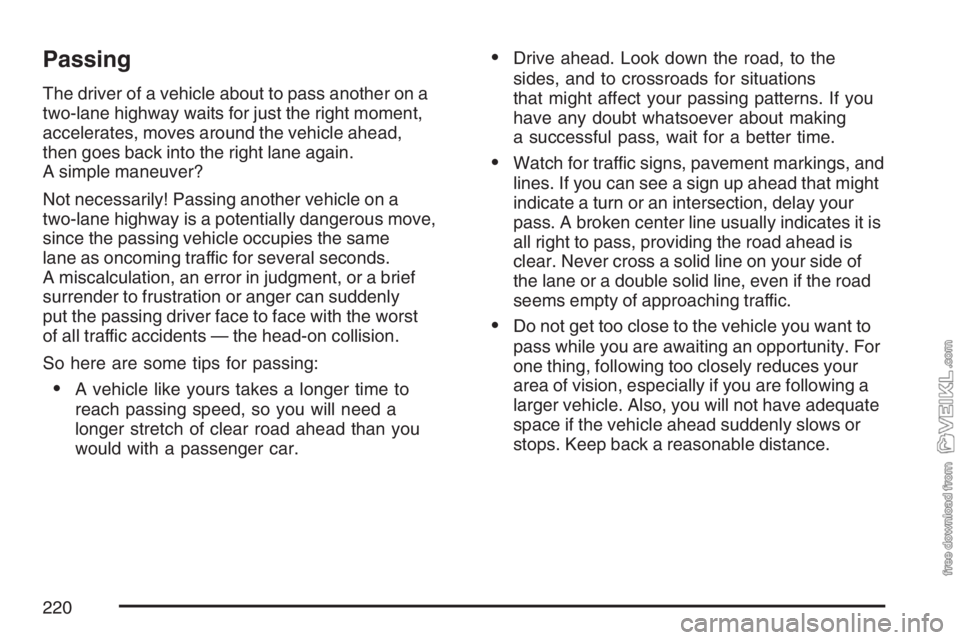
Passing
The driver of a vehicle about to pass another on a
two-lane highway waits for just the right moment,
accelerates, moves around the vehicle ahead,
then goes back into the right lane again.
A simple maneuver?
Not necessarily! Passing another vehicle on a
two-lane highway is a potentially dangerous move,
since the passing vehicle occupies the same
lane as oncoming traffic for several seconds.
A miscalculation, an error in judgment, or a brief
surrender to frustration or anger can suddenly
put the passing driver face to face with the worst
of all traffic accidents — the head-on collision.
So here are some tips for passing:
•A vehicle like yours takes a longer time to
reach passing speed, so you will need a
longer stretch of clear road ahead than you
would with a passenger car.
•Drive ahead. Look down the road, to the
sides, and to crossroads for situations
that might affect your passing patterns. If you
have any doubt whatsoever about making
a successful pass, wait for a better time.
•Watch for traffic signs, pavement markings, and
lines. If you can see a sign up ahead that might
indicate a turn or an intersection, delay your
pass. A broken center line usually indicates it is
all right to pass, providing the road ahead is
clear. Never cross a solid line on your side of
the lane or a double solid line, even if the road
seems empty of approaching traffic.
•Do not get too close to the vehicle you want to
pass while you are awaiting an opportunity. For
one thing, following too closely reduces your
area of vision, especially if you are following a
larger vehicle. Also, you will not have adequate
space if the vehicle ahead suddenly slows or
stops. Keep back a reasonable distance.
220